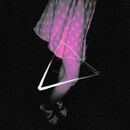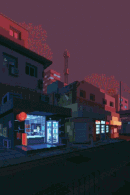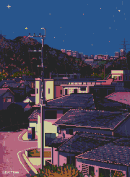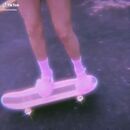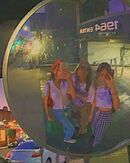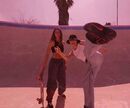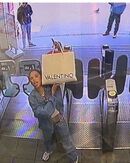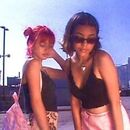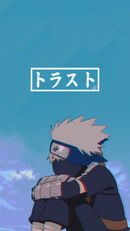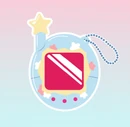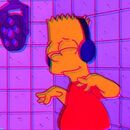Lo-Fi is a musical genre and aesthetic that uses muted tones and mundane imagery to evoke a feeling of calm and nostalgia. Primarily a genre of music, the minimal melody and repetitive cadence of Lo-Fi encourages people to stop in the moment and pay attention to the world around them, as opposed to the often-cynical use of nostalgia in other aesthetics. Visually, Lo-Fi features muted colors with simple or complex graphics amidst a peaceful scene.
Other aesthetics can blend with Lo-Fi, including Vaporwave, Animecore, Cartooncore, Dazecore, and Vintage, so long as the minimalism is preserved.
History[]
Generally, the aesthetic's origins are as a musical genre can be traced back to the American musician J Dilla and the Japanese musician Nujabes, as both played with a purposely low fidelity sound to make it sound more aged, but the aesthetic's rise in popularity can be traced back to Cartoon Network's late night [adult swim] block, which used a lot of Lo-Fi Hip-Hop beats for their Bumpers (the black screens with white text they'll air between programming and commercials) as well as airing Shinichiro Watanabe's Samurai Champloo, whose theme song was done by the aforementioned Nujabes.
On March 18, 2015, the YouTube channel Lofi Girl joined YouTube[1]. The channel is one of the most popular ways of discovering the genre. The channel hosts 24-hour music streams of this type of music all day, as well as themed playlists. As of May 2023, the channel has over 1.5 billion views.[1]
Visuals[]
Lo-Fi aesthetics often take on the color palette of Vaporwave and the imagery associated with Anime aesthetics, then utilize various Vintage-inspired tones and filters to create an experience that can evoke a nostalgic feeling in the viewer. Colors that typically appear vivid in photographs and drawings will instead be de-saturated and toned down, resulting in a dated or faded appearance (like it's from some time between the 1970s to the 2000s in the pre-HD era). The use of pastels is also commonly incorporated into Lo-Fi visuals, often giving the visuals a dreamy, nostalgic appearance. As with Lo-Fi music, the intentional degradation of image quality is also commonplace. Techniques such as the addition of visual noise, decreased contrast, static filters, and even chromatic aberration may be used for this purpose. While easily confused with Vaporwave, there are several key differences between the two, notably Vaporwave's more prevalent usage of computer-generated and surreal settings in combination with highly saturated colors compared to Lo-Fi's generally more grounded-in-reality visuals. To add to the longing and nostalgic vibe of Lo-Fi, oftentimes images of vintage toys, dead malls, old VHS tapes, and old photos can be utilized to elicit this effect as well.
Lately, a lot of Indie aesthetics seem to take a lot of notes from the Lo-Fi aesthetic, so it can be easy to confuse the two, but the most important distinction is Indie tends to have more of a Rock flavor to its aesthetics while Lo-Fi might go in a slightly pop direction. It's also not uncommon to see a lot of After Hours or Golden Hour aesthetics blend in with Lo-Fi or to utilize Lo-Fi artists to aid in creating the relaxed vibe it's going for.
Fashion[]
Fashion-wise, Lo-Fi's pretty forgiving and flexible; as long as it looks good in a VHS or Polaroid-style filter, you can pretty much wear anything and look good without having to break the bank: Vaporwave, Mallgoth, Hip-Hop, VSCO, Preppy, Indie, E-Girl/E-Boy, Softgirl/Softboy, Kawaii, Synthwave, Thriftcore, Hippie, Normcore, you name it and chances are it'll look good with a Lo-Fi filter placed over it. The most common version of Lo-Fi fashion, however, involves vintage-styled clothes with a washed-out/dull appearance or upcycling/thrifting old pieces into something new to aid in this Lo-Fi style.
Media[]
TV Shows[]
- Courage the Cowardly Dog
- Dexter's Laboratory
- Digimon (S 1-2)
- Duck Tales
- Johnny Bravo
- Looney Tunes
- Pokémon (S 1-8)
- Rugrats
- Scooby-Doo
- SpongeBob SquarePants (S 1-3)
- The Bugs Bunny Show
- The Powerpuff Girls
- Tom & Jerry
- Totally Spies
- Rocko's Modern Life
- Animaniacs
- Anthology series such as Nickelodeon's Special Delivery, MTV's Liquid Television, ABC's Weekend Specials.
- Sailor Moon
- Steven Universe
- The Simpsons
- Urusei Yatsura
- Cowboy Bebop
- Ed, Edd, n Eddy
Games[]
- Pokémon (Red/Blue/Yellow/Gold/Silver/Crystal)
- Animal Crossing
- Hiatus on the App Store - App Store - Applehttps://apps.apple.com › app › hiatus
- Welcome to Vibe Bus! - Robloxhttps://www.roblox.com › badges › Welcome-to-Vibe-...
- Welcome to Vibe Apartments ! - Robloxhttps://www.roblox.com › badges › Welcome-to-Vibe-...
Musical Subgenres[]
There are many primary genres of Lo-Fi music, but all share the feature of heavy usage of intentional sound quality degradation to achieve a more analog feel. High frequencies are also commonly avoided or minimized through things such as EQ and Low-Pass filters, resulting in a muted, low-intensity aura. Some of the types of Lo-Fi genres include seasonal mixes, as well as feelings (such as sad, lonely, and joyous). Lo-Fi summer mixes are the most common.
Lo-Fi Hip-Hop[]
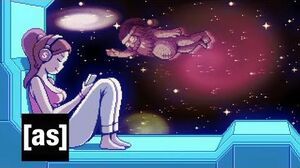
Study to - Rick and Morty - adult swim
By far the most popular of the Lo-Fi musical aesthetics, Lo-Fi Hip-Hop is a predominantly instrumental genre primarily designed to evoke feelings of nostalgia or calm. This genre commonly features songs with low and mid-tempos between 70s and 90s beats per minute, with 85 being a particularly common choice among artists. Samples from anime or other sources of recorded speech are frequently inserted into this music, and, while far less common, singing and rapping do occasionally appear in the genre as well. It is not to be confused with chillhop, a closely related jazz-based hip-hop sub-genre that utilizes much less intentional sound signal degradation and typically displays higher tempos, clearer mixes, and more bouncy properties instead. High frequencies are also not as avoided in chillhop as they are in Lo-Fi. Oftentimes, Lo-Fi is used to help one focus while studying, writing, reading, or performing other solo-activities that require concentration. Artists in the genre include:
Lo-Fi House[]
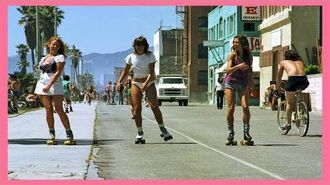
California Beach 80's - Lo-Fi House mix
Certainly the least well-known Lo-Fi genre, Lo-Fi House has been described as listening to music played at a nightclub from the outside. Lo-Fi House tends to take many musical cues and inspiration from 80's and 90's house music in particular, but still maintains the sense of nostalgia and relaxation that its hip-hop counterpart has, despite having more of a "dancey" beat. Artists in this genre include:
Chillwave[]
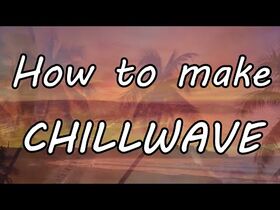
How to make CHILLWAVE
Chillwave (sometimes referred to as Lo-Fi Synthwave or Glo-Fi) is a music microgenre that emerged in the late 2000s. It is characterized by a faded or dreamy (or Lo-Fi) retro pop sound, escapist lyrics (frequent topics include the beach or summer), psychedelic or Lo-Fi aesthetics, mellow vocals, low-to-moderate tempos, heavy effects processing (especially reverb), and vintage synthesizers. Because of its overall aesthetic choices, Chillwave often finds itself getting confused with Vaporwave (which is made all the more confusing when Vaporwave is sometimes referred to as a subgenre of Chillwave).
Chillwave loosely emulates 1980s electropop and engages with notions of memory and nostalgia. It was one of the first music genres to develop primarily through the Internet. The term was coined in 2009 by the satirical blog Hipster Runoff to describe indie acts whose sounds resembled incidental music from 1980s VHS tapes. Its most prominent artists included Neon Indian, Washed Out, and Toro y Moi, who gained attention during 2009's "Summer of Chillwave". Washed Out's 2009 track "Feel It All Around" remains the best-known Chillwave song. Artists in this genre include:
- Ducktails
- HOME
- Hotel Pools
- Keep Shelly In Athens
- Memory Tapes
- MillionYoung
- Neon Indian
- Pictureplane
- Small Black
- Stumbleine
- Toro y Moi
- Tycho
- Washed Out
- Shiloh Dynasty
Resources[]
External links to help get a better understanding of this aesthetic.
Playlists[]
Lo-Fi Hip Hop[]
- lofi hip hop music - beats to relax/study to by Chilled Cow
- Lo-Fi Beats Official Spotify playlist
- Lofi Hip Hop & Chill Beats Spotify playlist by Delicieuse Musique
- Lo-fi Hip Hop Spotify playlist by Jay
- Lo Fi Hip Hop 3:30 AM Spotify playlist by Feardog Music
- Sad Lofi Hip Hop | Calm Lofi | Nostalgic Vibes Spotify playlist by aofd3
- Lo-Fi Hip Hop for Work from Home Spotify playlist by PlayStation™Music Japan
- Chillhop and Lo-Fi Vol. 1 Spotify playlist by avereo
- Lo-Fi Playlist #OPC by oldtowneast
- Soft Jams ~ Lo-Fi Beats By PeachChild
- The Sound of Lo-Fi Beats Spotify playlist by The Sounds of Spotify
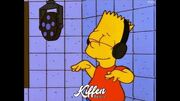
HOUSE¹ (Lo-Fi House Mix)
Lo-Fi House[]
- Lo-Fi House Official Spotify playlist
- Lofi House | Lo-fi Electronic | Breakbeat Spotify playlist by Mimi reads
- Lo-Fi House Cassette Spotify playlist by angelojnsn
- LO-FI HOUSE Spotify playlist by Niklas Fällén
- Lo-fi House Essentials Spotify playlist by Mixmag
- The Sound of Lo-Fi House Spotify playlist by The Sounds of Spotify
Chillwave[]
- Chillwave Spotify playlist by Timothy Walschaerts
- CHILLWAVE✨ Lofi Chill Synth (Nostalgic Synthwave/Dreampop) Spotify playlist by Astral Wizard
- Vaporwave / Synthwave for Focus 🎧 Spotify playlist by Evan Wall
- Chillwave 1 by Todafir Spotify playlist by Todafir
- The Sound of Chillwave Spotify playlist by The Sounds of Spotify



